
|
U. S. CIVIL WAR
PHOTOGRAPHS
|

|
STAUNTON RIVER BRIDGE
(The Battle of Old Men and Young Boys)
(PAGE 1 OF 2)

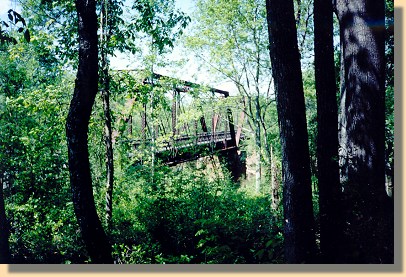
Staunton River Bridge - 2001 (3).
View from Confederate Rifle Pit.
In the text, the icon  is a link to the definition of the word it marks. is a link to the definition of the word it marks.
Use your
browser's "back" button to return to this page.
| |
Date: June 25, 1864
Estimated Casualties : 150 total : 150 total
On June 22, 1864 the cavalry divisions divisions of Brig. Gen.
James Wilson and Brig. Gen. August Kautz were dispatched from the Petersburg
lines to disrupt Confederate rail supply lines. Gen. U. S. Grant knew that if
these supply lines could be destroyed, Gen. R. E.Lee would have to abandon
Petersburg. The Federal troops left Petersburg with over 5,000 cavalry troops
and 16 pieces of artillery of Brig. Gen.
James Wilson and Brig. Gen. August Kautz were dispatched from the Petersburg
lines to disrupt Confederate rail supply lines. Gen. U. S. Grant knew that if
these supply lines could be destroyed, Gen. R. E.Lee would have to abandon
Petersburg. The Federal troops left Petersburg with over 5,000 cavalry troops
and 16 pieces of artillery . As they
moved west, pursued by Confederate General W. H. F. "Rooney" Lee and his cavalry,
Wilson's cavalry tore up 60 miles of track and burned two trains and several
railroad stations. . As they
moved west, pursued by Confederate General W. H. F. "Rooney" Lee and his cavalry,
Wilson's cavalry tore up 60 miles of track and burned two trains and several
railroad stations.
Just south of Roanoke Station (present-day Randolph, Virginia) was a long,
covered railroad bridge over the Staunton River, Wilson's final objective. The
bridge was defended by a battalion of 296 Confederate
reserves under the leadership of Captain Benjamin Farinholt. of 296 Confederate
reserves under the leadership of Captain Benjamin Farinholt.
On June 23rd, at 10 p.m., Capt. Farinholt received word from Gen. R. E. Lee that
a large detachment of enemy cavalry was moving his direction to destroy
the bridge and that he should "make every possible preparation immediately." That
night, Captain Farinholt sent off circulars urging the citizens of Halifax,
Charlotte, and Mecklenburg counties to assemble for the defense of the bridge,
and ordering all local companies
 to report immediately. to report immediately.
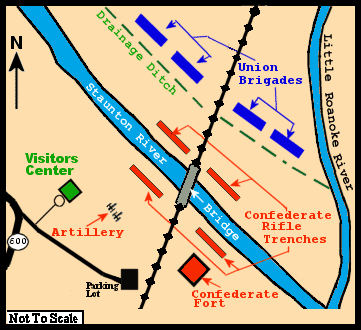
Staunton River Bridge - Battlefield Map
As a result of his circulars, by June 25th Capt. Farinholt's command had
increased to 938 men including 492 citizens. Farinholt was still badly
outnumbered. He had only six pieces of artillery, four were in the earthwork fort fort on the hill just
east of the bridge, and two in a small fortification on the hill just
east of the bridge, and two in a small fortification west of the
bridge. Between these artillery positions and the river was a line of trenches,
and across the bridge there was another line of hastily constructed
but well-concealed rifle trenches. Confederate Captain James A. Hoyt with his two
companies of regulars were on the east side of the bridge, and Colonel Henry
Eaton Coleman's "Old Men and Young Boys" were on the west side. Scouts and
pickets west of the
bridge. Between these artillery positions and the river was a line of trenches,
and across the bridge there was another line of hastily constructed
but well-concealed rifle trenches. Confederate Captain James A. Hoyt with his two
companies of regulars were on the east side of the bridge, and Colonel Henry
Eaton Coleman's "Old Men and Young Boys" were on the west side. Scouts and
pickets  were posted north
of the bridge near Roanoke Station. were posted north
of the bridge near Roanoke Station.
The Mulberry Hill plantation was located on a commanding hill near the
battlefield and the grounds of the house served as the Union headquarters and
field hospital during the battle. It is said that Mrs. McPhail, the lady of the
house, told the Federals that 10,000 Confederates lay in wait for them beyond the
breastworks and that every train was bringing more.
The Union cavalry arrived on a hill above the battlefield about 3.45 p.m. and
immediately opened with rifled Parrotts and 12-pounder
Napoleons and 12-pounder
Napoleons . The shells
striking the thin roof of the bridge made a fearful racket, scaring some of the
small boys into outbursts of weeping. . The shells
striking the thin roof of the bridge made a fearful racket, scaring some of the
small boys into outbursts of weeping.
General Kautz's cavalry troops were dismounted north of the bridge and formed up
to cross the open fields toward the bridge. They were receiving heavy fire from
the Confederate artillery on the other side of the river. Colonel Samuel R.
Spear's 1st D.C. and 11th Pa. approached along the east side of the railroad
and Colonel Robert M. West's 5th Pa. and 3rd N.Y. along the west side.
The Union troops reached a shallow drainage ditch some 150 yards north of the
bridge, and organized for what was to be the first of four separate charges, all
of them repulsed by the badly outnumbered Confederate forces. When the Union
forces left the drainage ditch for their first assault on the bridge, they were
met by intense fire from Col. Coleman's old men and young boys and the regulars
who had been hidden from view in their shallow trenches around the bridge.
It was during the fourth charge, when there was some misgivings about the
results, that General W. H. F. Lee and his division struck the rear-guard of
the Federals, causing them to have to fight in two different directions.
Finding that the Staunton River Bridge could not be carried without severe loss,
if at all, the Confederate cavalry being at their rear, and the Staunton
River too deep for fording, Union General James H. Wilson decided to discontinue
the battle and return to Petersburg. The withdrawal started around midnight.
The next morning, the Confederates advanced their line of skirmishers half a mile
and discovered that the enemy had left quite a number of their dead on the field.
8 Union soldiers were captured and 42 were buried. The reported Confederate
losses: 10 killed and 24 wounded.
(Text Source: U.S. Gov't, National Park Service and
Staunton River
Battlefield State Park)
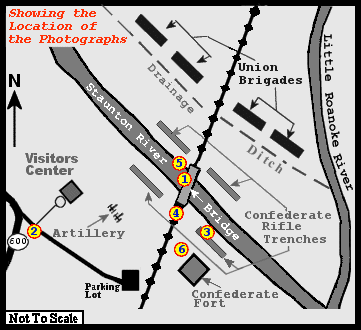
Location of Photographs in this Section
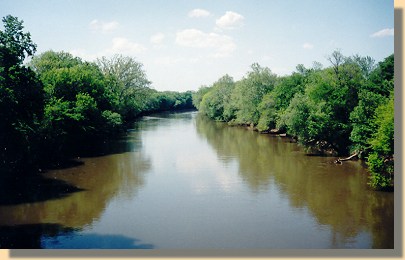
Staunton River - 2001 (1)
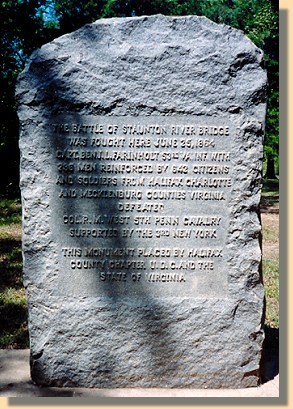
Staunton River Monument (6)
The Battle of Staunton River Bridge
was fought here June 25, 1864
Capt. Ben J.L. Farinholt 53rd VA Inf. with
296 men reinforced by 642 citizens
and soldiers from Halifax, Charolette
and Mecklenburg counties Virginia
Defeated
Col. R.M. West 5th Penn Cavalry
supported by the 3rd New York
This monument placed by Halifax
Chapter U.D.C. and the
State of Virginia
|
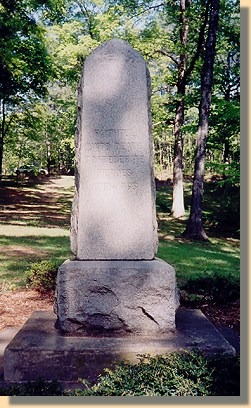
Staunton River Monument (6)
FAITHFUL
UNTO DEATH
CONFEDERATE
HEROES
1861 - 1865
|
|
|
PAGE TWO
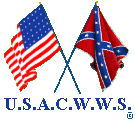 >
Civil War Photos
> Staunton River Bridge
>
Page 2
>
Civil War Photos
> Staunton River Bridge
>
Page 2
|
|










